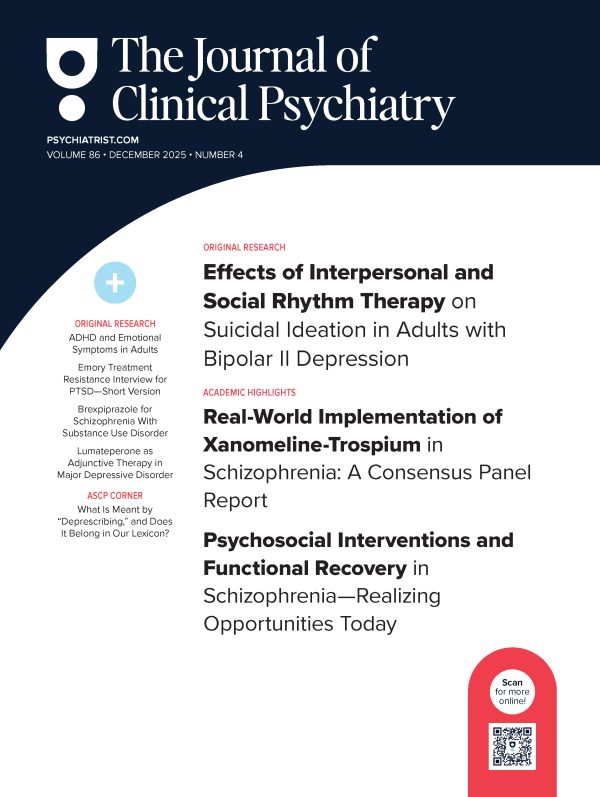Abstract
Objective: This study compared the effects of augmenting antidepressants with aripiprazole or repetitive transcranial magnetic stimulation (rTMS) versus switching to venlafaxine XR/duloxetine on quality of life (QoL) among patients with treatment resistant depression (TRD).
Methods: In a predefined secondary analysis of a multisite, open-label, effectiveness trial, patients with TRD were randomly assigned to aripiprazole augmentation, rTMS augmentation, or switching to venlafaxine XR/duloxetine in a 1:1:1 ratio, and they were treated for 8 weeks. TRD was defined as an inadequate response to 2 or more antidepressant trials of adequate dose and duration, as defined by the Massachusetts General Hospital Antidepressant Treatment Response Questionnaire. QoL was predefined as a key secondary end point for this study and assessed using the short form of the Quality of Life Enjoyment and Satisfaction Questionnaire (Q-LES-Q-SF). A mixed-effects model with repeated measures was applied. This study was conducted from July 13, 2017, to December 22, 2021.
Results: Among 258 randomized participants with at least 1 postbaseline Q-LES-Q-SF measurement, augmentation with aripiprazole demonstrated statistically significant superiority over switching on the Q-LES-Q-SF (P=.002), while rTMS did not (P=.326). At end point, changes from baseline in the Q-LES-Q-SF scores were 10.61 (SE=1.0) for aripiprazole augmentation, 11.59 (SE=1.1) for rTMS augmentation, and 8.68 (SE=0.9) for venlafaxine XR/duloxetine switch.
Conclusion: Augmentation with aripiprazole, but not rTMS, improved QoL significantly versus venlafaxine XR/duloxetine switch in TRD patients. However, a much smaller than expected sample size for the rTMS group may explain the lack of statistical significance rendering the latter finding of indeterminate nature.
Trial Registration: ClinicalTrials.gov identifier: NCT02977299.
J Clin Psychiatry 2025;86(3):24m15614
Author affiliations are listed at the end of this article.
Members Only Content
This full article is available exclusively to Professional tier members. Subscribe now to unlock the HTML version and gain unlimited access to our entire library plus all PDFs. If you’re already a subscriber, please log in below to continue reading.
References (40)

- Rapaport MH, Clary C, Fayyad R, et al. Quality-of-life impairment in depressive and anxiety disorders. Am J Psychiatry. 2005;162(6):1171–1178. PubMed CrossRef
- World Health Organization. Depressive disorder (depression). WHO website; 2023. Accessed August 14, 2024. https://www.who.int/news-room/fact-sheets/ detail/depression
- Rush AJ, Trivedi MH, Wisniewski SR, et al. Acute and longer-term outcomes in depressed outpatients requiring one or several treatment steps: a STAR*D report. Am J Psychiatry. 2006;163(11):1905–1917. PubMed CrossRef
- Voineskos D, Daskalakis ZJ, Blumberger DM. Management of treatment-resistant depression: challenges and strategies. Neuropsychiatr Dis Treat. 2020;16:221–234. PubMed CrossRef
- Fava M. Diagnosis and definition of treatment-resistant depression. Biol Psychiatry. 2003;53(8):649–659. PubMed CrossRef
- Al-Harbi KS. Treatment-resistant depression: therapeutic trends, challenges, and future directions. Patient Prefer Adherence. 2012;6:369–388. PubMed CrossRef
- Endicott J, Nee J, Harrison W, et al. Quality of Life Enjoyment and Satisfaction Questionnaire: a new measure. Psychopharmacol Bull. 1993;29(2):321–326. PubMed
- Engel GL. The clinical application of the biopsychosocial model. Am J Psychiatry. 1980;137(5):535–544. PubMed CrossRef
- Hohls JK, König HH, Quirke E, et al. Anxiety, depression and quality of life—A systematic review of evidence from longitudinal observational studies. Int J Environ Res Public Health. 2021;18(22):12022. PubMed CrossRef
- Saarijärvi S, Salminen JK, Toikka T, et al. Health-related quality of life among patients with major depression. Nord J Psychiatry. 2002;56:261–264. PubMed
- IsHak WW, Balayan K, Bresee C, et al. A descriptive analysis of quality of life using patient-reported measures in major depressive disorder in a naturalistic outpatient setting. Qual Life Res. 2013;22(3):585–596. PubMed CrossRef
- Bonicatto SC, Dew MA, Zaratiegui R, et al. Adult outpatients with depression: worse quality of life than in other chronic medical diseases in Argentina. Soc Sci Med. 2001;52(6):911–919. PubMed CrossRef
- IsHak WW, Greenberg JM, Balayan K, et al. Quality of life: the ultimate outcome measure of interventions in major depressive disorder. Harv Rev Psychiatry. 2011;19(5):229–239. PubMed CrossRef
- Mauskopf JA, Simon GE, Kalsekar A, et al. Nonresponse, partial response, and failure to achieve remission: humanistic and cost burden in major depressive disorder. Depress Anxiety. 2009;26(1):83–97. PubMed CrossRef
- Johnston KM, Powell LC, Anderson IM, et al. The burden of treatment-resistant depression: a systematic review of the economic and quality of life literature. J Affect Disord. 2019;242:195–210. PubMed CrossRef
- Dennehy EB, Marangell LB, Martinez J, et al. Clinical and functional outcomes of patients who experience partial response to citalopram: secondary analysis of STAR*D. J Psychiatr Pract. 2014;20(3):178–187. PubMed CrossRef
- McIntyre RS, Cha DS, Soczynska JK, et al. Cognitive deficits and functional outcomes in major depressive disorder: determinants, substrates, and treatment interventions. Depress Anxiety. 2013;30(6):515–527. PubMed CrossRef
- The Lancet Psychiatry Measuring Success. The problem with primary outcomes. Lancet Psychiatry. 2020;7:1. PubMed
- Kamenov K, Cabello M, Coenen M, et al. How much do we know about the functional effectiveness of interventions for depression? A systematic review. J Affect Disord. 2015;188:89–96. PubMed CrossRef
- Lam RW, Filteau MJ, Milev R. Clinical effectiveness: the importance of psychosocial functioning outcomes. J Affect Disord. 2011;132(suppl 1):S9–S13. PubMed CrossRef
- Kamenov K, Twomey C, Cabello M, et al. The efficacy of psychotherapy, pharmacotherapy and their combination on functioning and quality of life in depression: a meta-analysis. Psychol Med. 2017;47(3):414–425. PubMed CrossRef
- McKnight PE, Kashdan TB. The importance of functional impairment to mental health outcomes: a case for reassessing our goals in depression treatment research. Clin Psychol Rev. 2009;29(3):243–259. PubMed CrossRef
- IsHak WW, Mirocha J, James D, et al. Quality of life in major depressive disorder before/after multiple steps of treatment and one-year follow-up. Acta Psychiatr Scand. 2015;131(1):51–60. PubMed CrossRef
- Zimmerman M, Martinez JA, Attiullah N, et al. Why do some depressed outpatients who are in remission according to the Hamilton Depression Rating Scale not consider themselves to be in remission? J Clin Psychiatry. 2012;73(6):790–795. PubMed CrossRef
- Zimmerman M, McGlinchey JB, Posternak MA, et al. How should remission from depression be defined? The depressed patient’s perspective. Am J Psychiatry. 2006;163(1):148–150. PubMed CrossRef
- Cohen RM, Greenberg JM, IsHak WW. Incorporating multidimensional patient-reported outcomes of symptom severity, functioning, and quality of life in the individual burden of illness index for depression to measure treatment impact and recovery in MDD. JAMA Psychiatry. 2013;70(3):343–350. PubMed CrossRef
- Lex H, Ginsburg Y, Sitzmann AF, et al. Quality of life across domains among individuals with treatment-resistant depression. J Affect Disord. 2019;243:401–407. PubMed CrossRef
- McCall WV, Reboussin BA, Cohen W, et al. Electroconvulsive therapy is associated with superior symptomatic and functional change in depressed patients after psychiatric hospitalization. J Affect Disord. 2001;63(1–3):17–25. PubMed CrossRef
- McCall WV, Dunn A, Rosenquist PB. Quality of life and function after electroconvulsive therapy. Br J Psychiatry. 2004;185(5):405–409. PubMed CrossRef
- IsHak WW, Bonifay W, Collison K, et al. The Recovery Index: a novel approach to measuring recovery and predicting remission in major depressive disorder. J Affect Disord. 2017;208:369–374. PubMed CrossRef
- Lam RW, Parikh SV, Michalak EE, et al. Canadian Network for Mood and Anxiety Treatments (CANMAT) consensus recommendations for functional outcomes in major depressive disorder. Ann Clin Psychiatry. 2015 May;27(2):142–149. PubMed
- Kennedy SH, Lam RW, McIntyre RS, et al. Canadian Network for Mood and Anxiety Treatments (CANMAT) 2016 Clinical Guidelines for the Management of Adults with Major Depressive Disorder: Section 3. Pharmacological Treatments. Can J Psychiatry. 2016;61(9):540–560. PubMed CrossRef
- Cleare A, Pariante CM, Young AH, et al. Evidence-based guidelines for treating depressive disorders with antidepressants: a revision of the 2008 British Association for Psychopharmacology guidelines. J Psychopharmacol. 2015;29(5):459–525. PubMed CrossRef
- IsHak WW, Mirocha J, Pi S, et al. Patient-reported outcomes before and after treatment of major depressive disorder. Dialogues Clin Neurosci. 2014;16(2):171–183. PubMed CrossRef
- Morton E, Michalak EE, Levitt A, et al. Quality of life impacts of bright light treatment, fluoxetine, and the combination in patients with nonseasonal major depressive disorder: a randomized clinical trial. Can J Psychiatry. 2021 Mar;66(3):289–297. PubMed CrossRef
- Papakostas GI, Trivedi MH, Shelton RC, et al. Comparative Effectiveness Research Trial for Antidepressant Incomplete and Non-Responders With Treatment Resistant Depression (ASCERTAIN-TRD): a randomized clinical trial. Mol Psychiatry. 2024;29(8):2287–2295. PubMed CrossRef
- Stevanovic D. Quality of Life Enjoyment and Satisfaction Questionnaire-short form for quality of life assessments in clinical practice: a psychometric study. J Psychiatr Ment Health Nurs. 2011;18(8):744–750. PubMed CrossRef
- Lee YT, Liu SI, Huang HC, et al. Validity and reliability of the Chinese version of the Short Form of Quality of Life Enjoyment and Satisfaction Questionnaire (Q-LES-Q-SF). Qual Life Res. 2014;23(3):907–916. PubMed CrossRef
- Kraemer HC, Kupfer DJ. Size of treatment effects and their importance to clinical research and practice. Biol Psychiatry. 2006;59(11):990–996. PubMed CrossRef
- Cohen J. Statistical power analysis for the behavioral sciences. 2nd ed. Lawrence Erlbaum Associates; 1988.





